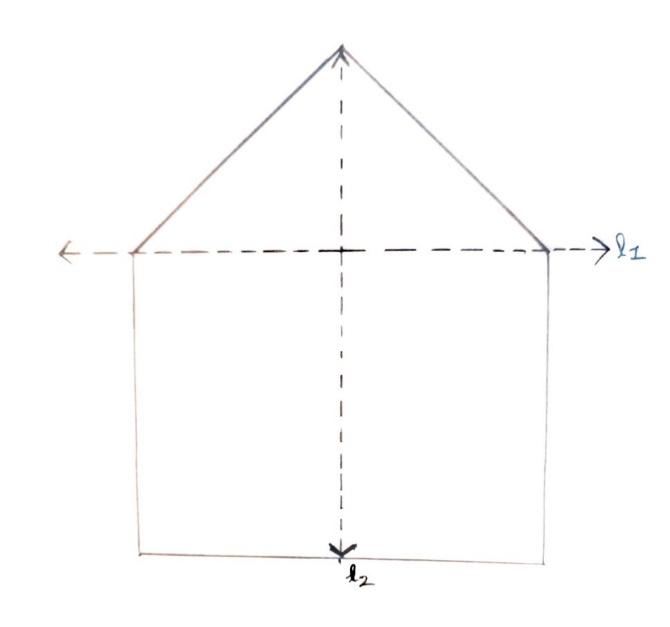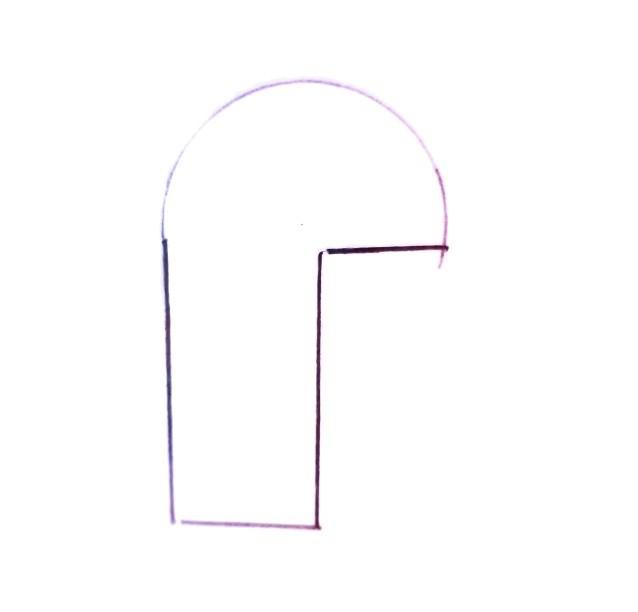1. Name four symmetric thingss in your house or school.
1. Name four symmetric thingss in your house or school.
Explanation:
The four symmetric things are photo frames, notebooks, scissors and computer diskettes.
2. According to the figure below, which of l1 and l2 is the mirror line?

2. According to the figure below, which of l1 and l2 is the mirror line?
Explanation:
l2 is the line mirrored in the image. When a given figure is folded around line l2, the left side just
overlaps the right side, and vice versa.
3. Identify the shape below. Check that they are symmetrical.
Draw a symmetrical line
3. Identify the shape below. Check that they are symmetrical.
Draw a symmetrical line
Explanation:
Yes, it has a symmetric line
4. Recognize the shape below. Check that they are symmetrical. Draw symmetric lines

4. Recognize the shape below. Check that they are symmetrical. Draw symmetric lines
Explanation:
No, it has no symmetrical lines
5. Recognize the shape below. Check that they are symmetrical.
Draw symmetrical lines
5. Recognize the shape below. Check that they are symmetrical.
Draw symmetrical lines
Explanation
Yes, it has symmetric lines
6. Recognize the shape below. Check that they are symmetrical. Draw symmetrical lines
6. Recognize the shape below. Check that they are symmetrical. Draw symmetrical lines
Explanation:
Yes, it has symmetrical lines
7. Copy the following onto a square piece of paper. Then finish them off so that the dotted lines are lines of symmetry.
7. Copy the following onto a square piece of paper. Then finish them off so that the dotted lines are lines of symmetry.
Explanation:
In order to make the line a symmetric line, the below figures be drawn:
(a)
(b)
(c)
(d)
(e)
(f)
8. In the below diagram l is the symmetric axis. complete the below diagram so it is symmetrical.
8. In the below diagram l is the symmetric axis. complete the below diagram so it is symmetrical.
Explanation:
The diagram below is the correct one for it to be symmetric:
9. l in the diagram below is the symmetrical axis.
Sketch the diagram of the triangle and fill the scheme so that the figure becomes symmetric.
9. l in the diagram below is the symmetrical axis.
Sketch the diagram of the triangle and fill the scheme so that the figure becomes symmetric.
Explanation:
The triangles required should be sketched as symmetric figures as below:
10. Draw the triangles in the following figures onto the grid paper. In every case sketch the symmetric axis and find the triangle type.
10. Draw the triangles in the following figures onto the grid paper. In every case sketch the symmetric axis and find the triangle type.
Explanation:
(a) The above triangle is an isosceles triangle. Then there will be only one symmetrical axis
(b) The triangle given is an isosceles triangle. Then there will be only one symmetrical axis
(c) The triangle given is a right angled triangle. Then there will be only one symmetrical axis
(d) The triangle given is a scalene triangle.
Then there will be no symmetrical lines.
11. Complete the form below.
11. Complete the form below.
Explanation:
The given form can be filled as follows:
12. Can you draw a triangle with exactly one line of symmetry?
12. Can you draw a triangle with exactly one line of symmetry?
Explanation:
Yes, we can sketch a isosceles triangle with one symmetrical axis.
13. Can you sketch a triangle with two symmetrical axes?
13. Can you sketch a triangle with two symmetrical axes?
Explanation:
No, you cannot draw a triangle with two axes of symmetry.
14. Can you draw a triangle with exactly three symmetrical lines?
14. Can you draw a triangle with exactly three symmetrical lines?
Explanation:
Yes, we can sketch an equilateral triangle with 3 symmetrical lines.
15. Can you draw a triangle with no symmetric axis?
15. Can you draw a triangle with no symmetric axis?
Explanation:
Yes, you can sketch a scalene triangle without an axis of symmetry.
16. Draw a triangle with a horizontal symmetric line but no vertical symmetric lines on a grid paper
16. Draw a triangle with a horizontal symmetric line but no vertical symmetric lines on a grid paper
Explanation:
A triangle with a horizontal symmetrical line but with no vertical symmetric line can be drawn as below:
17. On grid paper, draw a quadrilateral with both horizontal and vertical symmetric lines
17. On grid paper, draw a quadrilateral with both horizontal and vertical symmetric lines
Explanation:
Quadrilateral that can be drawn with horizontal and vertical lines of symmetry is:
18. On grid paper, draw a quadrilateral with a horizontal symmetric line but with no vertical symmetrical line.
18. On grid paper, draw a quadrilateral with a horizontal symmetric line but with no vertical symmetrical line.
Explanation:
A quadrilateral with a horizontal symmetrical axis but with no vertical symmetrical axis is as follows:
19. On a square piece of paper, draw a hexagon with exactly two axes of symmetry.
19. On a square piece of paper, draw a hexagon with exactly two axes of symmetry.
Explanation:
A hexagon with exactly two axes of symmetry can be drawn as follows:
20. On a square sheet of paper, draw a hexagon with two axes of symmetry.
20. On a square sheet of paper, draw a hexagon with two axes of symmetry.
Explanation:
A hexagon with six symmetrical axes can be drawn as below:
21. Find the diagram below and draw the symmetric axes, if any:
21. Find the diagram below and draw the symmetric axes, if any:
Explanation:
The triangle given is an isosceles. So there will be only one symmetric axis.
22. Find the diagram below and draw the symmetrical axes:
22. Find the diagram below and draw the symmetrical axes:
Explanation:
The given figure has two symmetrical lines.
23. find the figure below and draw the symmetrical lines:
23. find the figure below and draw the symmetrical lines:
Explanation:
The above figure has 4 symmetrical lines.
24. Find the diagram below and draw the symmetrical lines:
24. Find the diagram below and draw the symmetrical lines:
Explanation:
The above figure is an octagon and it has 2 symmetrical lines.
25. Find the figure below and draw the lines of symmetry, if any:
25. Find the figure below and draw the lines of symmetry, if any:
Explanation:
The figure given has only one line of symmetry.
26. Find the figure below and draw the lines of symmetry, if any:
26. Find the figure below and draw the lines of symmetry, if any:
Explanation:
The given figure has 4 symmetrical lines.
27. Take all the letters of the English alphabets. Make list of the letters with vertical symmetrical lines
27. Take all the letters of the English alphabets. Make list of the letters with vertical symmetrical lines
Explanation:
Alphabets with vertical symmetrical lines are A, H, I, M, O, T, U, V, W , X, Y
28. Take all the letters of the English alphabets. Make list of the letters with horizontal symmetrical lines
28. Take all the letters of the English alphabets. Make list of the letters with horizontal symmetrical lines
Explanation:
Alphabets with horizontal symmetrical lines are B, C, D, E, H, I, K, oh, X
29. Take all the letters of the English alphabets. Make list of the letters with no symmetrical lines
29. Take all the letters of the English alphabets. Make list of the letters with no symmetrical lines
Explanation:
The letters that have no axis of symmetry are F, G, J, L, N, P, Q, R, S, Z.
30. Below are some graphs of the folded paper and the design drawn around the fold. In each case, an
approximate drawing of the complete figure is drawn, which will be seen when the drawing is cut.
30. Below are some graphs of the folded paper and the design drawn around the fold. In each case, an
approximate drawing of the complete figure is drawn, which will be seen when the drawing is cut.
Explanation:
We can complete the figure as below:
31. Copy the following picture onto grid paper. Complete each so that the final figure has two dotted lines as the two symmetrical lines.
How do you complete the picture ?
31. Copy the following picture onto grid paper. Complete each so that the final figure has two dotted lines as the two symmetrical lines.
How do you complete the picture ?
Explanation:
These diagrams can be completed by drawing equal parts as shown in these diagrams. Either cross the vertical line of symmetry first then the horizontal line of symmetry, or cross the horizontal line of symmetry first then the vertical line of symmetry.
The above diagram after completion are as follows.
32. In each figure, a letter of the alphabet is represented along a vertical line. Obtain a mirror image of the characters in the given line. Find out which letters look the same after reflection (i.e. which letters look the same in the picture) and which do not. Can you guess why?
Try for O E M N P H L T S V X
32. In each figure, a letter of the alphabet is represented along a vertical line. Obtain a mirror image of the characters in the given line. Find out which letters look the same after reflection (i.e. which letters look the same in the picture) and which do not. Can you guess why?
Try for O E M N P H L T S V X
Explanation:
The below are the mirror images:
Also Read: Chapter 14: Practical Geometry



